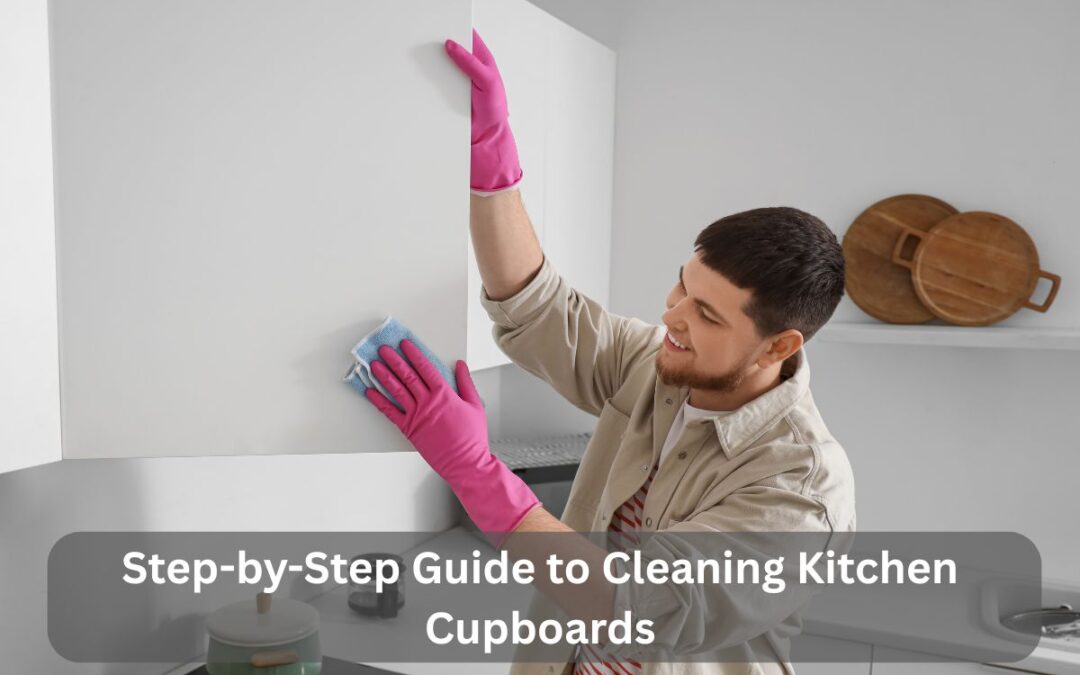Kitchen cupboards are one of the most used areas in your home. From storing everyday dishes to housing snacks, oils, and spices, they encounter fingerprints, grease, and even food spills. Over time, these little messes add up and can make your kitchen feel less fresh. The good news is that cleaning kitchen cupboards doesn’t need to be overwhelming — with the right routine, you can bring back their shine and keep them looking spotless.
Key Takeaways
- Wipe cupboards weekly to prevent grime buildup.
- Use different cleaners depending on the material of your cupboards.
- Remove contents every few months for a full deep clean.
- Always dry thoroughly to prevent water damage and warping.
- Use liners and organizers to make future cleaning easier.
Why Is It Important to Clean Kitchen Cupboards?
Kitchen cupboards collect grease, dust, and bacteria from daily cooking. If left uncleaned, these contaminants can damage the surface and even attract pests. Regular cleaning not only improves hygiene but also extends the life of your cupboards.
What Supplies Do You Need?
Before starting, gather your cleaning essentials. Having everything ready makes the process smooth and efficient.
- Microfiber cloths
- Soft sponge
- Mild dish soap
- White vinegar (diluted)
- Baking soda (for tough spots)
- Spray bottle
- Small brush or old toothbrush
- Vacuum with brush attachment
- Dry towels
Step 1: Empty the Cupboards
You can’t clean effectively around cans and plates. Clearing the space first allows you to reach every surface.
- Remove all items from the cupboard.
- Check for expired food and dispose of it.
- Group similar items together for easier restocking.
Step 2: Dust and Vacuum
Even closed cupboards collect dust and crumbs. Removing them first prevents smearing when you wipe with a damp cloth.
- Use a vacuum with brush attachment to remove loose debris.
- Dust corners and shelf edges with a microfiber cloth.
Step 3: Clean the Interior
Now that the shelves are empty, it’s time to clean inside. The method depends on the cupboard material.
Wooden Cupboards
Wood is sensitive to moisture, so avoid soaking it.
- Mix a few drops of dish soap with warm water.
- Dip a cloth in the solution, wring it well, and wipe surfaces.
- Dry immediately with a soft towel.
Laminate or Painted Cupboards
These are easier to clean and can handle light moisture.
- Spray diluted vinegar solution (1:1 water and vinegar).
- Wipe with a microfiber cloth.
- For stubborn spots, use baking soda paste (baking soda + water).
Glass-Front Cupboards
Glass shows smudges easily.
- Spray with glass cleaner or vinegar-water solution.
- Wipe with a lint-free cloth.
- Polish dry for streak-free shine.
Step 4: Clean Cupboard Doors and Handles
Handles are high-touch areas where germs gather. Giving them special attention keeps your kitchen more hygienic.
- Wipe doors with the same solution used inside (based on material).
- Use a toothbrush to scrub around handles and edges.
- Dry thoroughly to prevent streaks or water spots.
Step 5: Tackle Grease Buildup
Grease is common on cupboards near the stove. It sticks dust and can be difficult to remove if left for long.
- Mix dish soap with warm water for mild grease.
- For heavy buildup, use a vinegar-water spray.
- Stubborn spots? Apply baking soda paste, let sit 5 minutes, and scrub gently.
Step 6: Clean the Cupboard Tops
If your cupboards don’t go up to the ceiling, the tops can collect grease and dust.
- Wipe with vinegar-water solution.
- To prevent future buildup, place a sheet of wax paper or newspaper on top. Replace every few months.
Step 7: Organize Before Restocking
A clean cupboard deserves a neat restock. This makes maintenance easier.
- Wipe containers and jars before putting them back.
- Use organizers, bins, or shelf risers for better space use.
- Consider shelf liners to protect surfaces from spills.
Step 8: Final Buff and Shine
Once everything is back in place, give your cupboards a final touch.
- Buff wooden cupboards with a small amount of mineral oil for shine.
- Polish glass or stainless handles for a clean finish.
Maintenance Tips
- Wipe cupboard exteriors weekly with a damp cloth.
- Deep clean interiors every 3–4 months.
- Use an exhaust fan while cooking to reduce grease buildup.
- Handle spills immediately before they harden.
FAQs
Can I use bleach on cupboards?
No, bleach can damage finishes. Stick to mild soap or vinegar.
How do I clean sticky cupboard doors?
Use dish soap and warm water. For stubborn stickiness, baking soda paste works well.
What’s the best way to prevent cupboard odors?
Keep shelves dry, clean regularly, and place an open box of baking soda inside to absorb smells.
Final Thoughts
Cleaning kitchen cupboards may feel like a chore, but breaking it into steps makes it easy. Start with emptying and dusting, clean with safe solutions depending on the material, and finish by organizing and drying thoroughly. With regular maintenance, your cupboards will stay spotless, odor-free, and long-lasting.

As the chief content writer, Hassan Al Sarker works as a professional kitchen-based content creator at Kitchen Liker.
In addition to reviewing the content published on Kitchen Liker, he ensures that it is accurate, relevant, and helpful. As a result, all the reviews and information published at Kitchen Liker are neutral and userfriendly.
Hassan Al Sarker has a bachelor’s degree in Hotel and Tourism Management From the Newyork University. Before joining Kitchen Liker, he was a contributor at Kitchen Club, United States.

